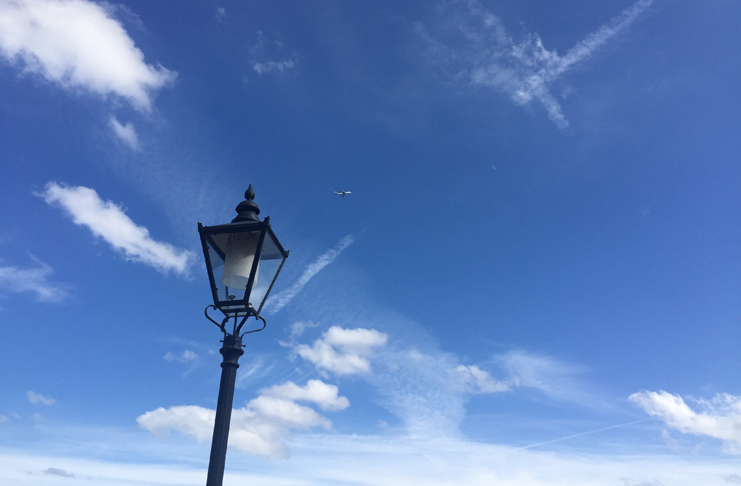
TravelingForMiles.com may receive commission from card issuers. Some or all of the card offers that appear on TravelingForMiles.com are from advertisers and may impact how and where card products appear on the site. TravelingForMiles.com does not include all card companies or all available card offers.
Some links to products and travel providers on this website will earn Traveling For Miles a commission that helps contribute to the running of the site. Traveling For Miles has partnered with CardRatings for our coverage of credit card products. Traveling For Miles and CardRatings may receive a commission from card issuers. Opinions, reviews, analyses & recommendations are the author’s alone and have not been reviewed, endorsed or approved by any of these entities. For more details please see the disclosures found at the bottom of every page.
Updated 14 March 2020 11:00 PST – The US has now added the UK and the Republic of Ireland to the travel ban.
The United States has announced a 30-day ban on travel from 26 28 European countries to the United States which will come into force late on Friday 13 March 2020 (the UK/Ireland ban starts on 16 March). The counties affected are those signed up to the Schengen Agreement which abolished all forms of border control at the countries’ mutual borders and, as of 14 March, the UK and the Republic of Ireland.
I’m not going to comment on the rights or wrongs of this ban or add any personal thoughts – this is just a post to get a few facts out into the world (something that quite a few news outlets should consider doing).
The Affected Countries
-
- Austria
- Belgium
- Czech Republic
- Denmark
- Estonia
- Finland
- France
- Germany
- Greece
- Hungary
- Iceland
- Italy
- Latvia
- Lichtenstein
- Lithuania
- Luxembourg
- Malta
- Netherlands
- Norway
- Poland
- Portugal
- Republic of Ireland
- Slovakia
- Slovenia
- Spain
- Sweden
- Switzerland
- United Kingdom
Who Is Banned From Traveling To The US?
There has been a lot of incorrect information published by various news outlets surrounding who is and who isn’t banned from traveling to the US…including this gem from the BBC:
“…the ban applies to anyone who has been in the EU’s Schengen border-free area within 14 days prior to their arrival in the US“
That’s simply not true. The ban definitely does not cover “anyone” who has traveled to the Schengen Area.
The Department of Homeland Security has confirmed that the ban applies to “most foreign nationals” who have been in the listed countries in the 14 days prior to their scheduled arrival in the United States but also goes on to say:
“This does not apply to legal permanent residents, (generally) immediate family members of U.S. citizens, and other individuals who are identified in the proclamation.”
To further clarify, the text of the presidential proclamation that brought about the ban says the following (this is the text before the UK and the Republic of Ireland were added to the ban):
Section 1. Suspension and Limitation on Entry. The entry into the United States, as immigrants or nonimmigrants, of all aliens who were physically present within the Schengen Area during the 14-day period preceding their entry or attempted entry into the United States is hereby suspended and limited subject to section 2 of this proclamation.
Sec. 2. Scope of Suspension and Limitation on Entry.
(a) Section 1 of this proclamation shall not apply to:
(i) any lawful permanent resident of the United States;
(ii) any alien who is the spouse of a U.S. citizen or lawful permanent resident;
(iii) any alien who is the parent or legal guardian of a U.S. citizen or lawful permanent resident, provided that the U.S. citizen or lawful permanent resident is unmarried and under the age of 21;
(iv) any alien who is the sibling of a U.S. citizen or lawful permanent resident, provided that both are unmarried and under the age of 21;
(v) any alien who is the child, foster child, or ward of a U.S. citizen or lawful permanent resident, or who is a prospective adoptee seeking to enter the United States pursuant to the IR-4 or IH-4 visa classifications;
(vi) any alien traveling at the invitation of the United States Government for a purpose related to containment or mitigation of the virus;
(vii) any alien traveling as a nonimmigrant pursuant to a C-1, D, or C-1/D nonimmigrant visa as a crewmember or any alien otherwise traveling to the United States as air or sea crew;
(viii) any alien
(A) seeking entry into or transiting the United States pursuant to one of the following visas: A-1, A-2, C-2, C-3 (as a foreign government official or immediate family member of an official), E-1 (as an employee of TECRO or TECO or the employee’s immediate family members), G-1, G-2, G-3, G-4, NATO-1 through NATO-4, or NATO-6 (or seeking to enter as a nonimmigrant in one of those NATO categories); or
(B) whose travel falls within the scope of section 11 of the United Nations Headquarters Agreement;
(ix) any alien whose entry would not pose a significant risk of introducing, transmitting, or spreading the virus, as determined by the Secretary of Health and Human Services, through the CDC Director or his designee;
(x) any alien whose entry would further important United States law enforcement objectives, as determined by the Secretary of State, the Secretary of Homeland Security, or their respective designees, based on a recommendation of the Attorney General or his designee;
(xi) any alien whose entry would be in the national interest, as determined by the Secretary of State, the Secretary of Homeland Security, or their designees; or
(xii) members of the U.S. Armed Forces and spouses and children of members of the U.S. Armed Forces.
That’s quite a long list of categories of people who are not banned from traveling to the US (even if they have been traveling within countries listed in the ban) and those categories cover a significant number of people.
When Does The Ban Take Effect?
The presidential proclamation comes into effect at 11:59 pm eastern daylight time on 13 March 2020 but does not apply to travelers onboard flights that departed before that time but that will land in the US after that time.
The ban on travel from the UK and the Republic of Ireland starts from midnight EST on Monday 16 March 2020.
When Does The Ban End?
In his television address, President Trump said that the ban would cover “the next 30 days” but it’s worth noting that the presidential proclamation that he signed makes no mention of that limitation. Section 4 of the proclamation only says this:
This proclamation shall remain in effect until terminated by the President. The Secretary of Health and Human Services shall recommend that the President continue, modify, or terminate this proclamation as described in section 5 of Proclamation 9984, as amended.
Based on the wording above there’s nothing to prevent the ban going past 30 days if the president takes no further action.
Bottom Line
Generally speaking (read the post above for specifics), if you’re not a US national, a legal resident of the US or closely related to a US national/legal resident of the US and you have been traveling in a country that’s listed above in the past 14 days, you are banned from traveling to the United States for at least the next 30 days.
If you’re a US national, a legal resident of the US or closely related to a US national/legal resident of the US, you’re free to return to the US regardless of where you have been traveling.

















[…] the news that the United States is banning select travelers from entering the country if they have been traveling in any one of the 26 European countries signed up to the Schengen […]
[…] a lot of people about to fall foul of a ban on travel between most European countries and the US, we’re starting to see airlines updating their waivers to include transatlantic travel and […]
[…] latest big changes to hit the US airlines are the ban on travel between select European countries and the US (which comes into force tonight) and the ban on travel between the US and Argentina that the […]
[…] in Ireland, the United Kingdom, and continental Europe as the airline reminds passengers that travel between the US and UK/Ireland isn’t covered by the ban and that US citizens and residents are still allowed to travel back and forth across the Atlantic […]
Also understand that a US Citizen (or one of the other allowed classifications) will still have to go through specific airports for reentry, be subject to additional screening and enter into a 14 day isolation period.
Probably necessary and worth it if it slows down spread of COVID-19 but still a hugely disruptive factor (even for US Citizens).
[…] the light of the European travel ban that’s coming into effect tomorrow, Hilton has added all 26 countries that are signed up to the Schengen Agreement to its list of […]